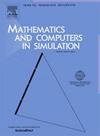Composite likelihood expectation–maximization algorithm for the first-order multivariate integer-valued autoregressive model with multivariate mixture distributions
IF 4.4
2区 数学
Q1 COMPUTER SCIENCE, INTERDISCIPLINARY APPLICATIONS
引用次数: 0
Abstract
In this paper, we develops a estimation framework for first-order multivariate integer-valued autoregressive (MINAR(1)) models with multivariate Poisson-lognormal (MPL) or multivariate geometric-logitnormal (MGL) innovations. Owing to the structural complexity of the MINAR(1) framework and the latent dependence in MPL/MGL innovation processes, the likelihood functions involve summations and integrals. Traditional expectation–maximization (EM) algorithms face prohibitive computational demands as model dimensionality increases. To address this, we propose a composite likelihood expectation–maximization (CLEM) algorithm that strategically combines composite likelihood with the EM algorithm, reducing the computational burden. Furthermore, we implement a Cholesky parameterization for the covariance matrix to ensure positive definiteness. Through comprehensive Monte Carlo simulations, we demonstrate the performance of CLEM algorithm. Finally, we validate the method’s practical utility by analyzing a real-world dataset.
多元混合分布一阶多元整值自回归模型的复合似然期望最大化算法
在本文中,我们开发了一个具有多元泊松-对数正态(MPL)或多元几何-对数正态(MGL)创新的一阶多元整值自回归(MINAR(1))模型的估计框架。由于MINAR(1)框架的结构复杂性和MPL/MGL创新过程的潜在依赖性,似然函数涉及求和和积分。随着模型维数的增加,传统的期望最大化(EM)算法面临着令人望而却步的计算需求。为了解决这个问题,我们提出了一种复合似然期望最大化(CLEM)算法,该算法将复合似然与EM算法巧妙地结合起来,减少了计算负担。此外,我们实现了协方差矩阵的Cholesky参数化,以确保正确定性。通过全面的蒙特卡罗模拟,我们验证了CLEM算法的性能。最后,我们通过分析一个真实的数据集来验证该方法的实用性。
本文章由计算机程序翻译,如有差异,请以英文原文为准。
求助全文
约1分钟内获得全文
求助全文
来源期刊

Mathematics and Computers in Simulation
数学-计算机:跨学科应用
CiteScore
8.90
自引率
4.30%
发文量
335
审稿时长
54 days
期刊介绍:
The aim of the journal is to provide an international forum for the dissemination of up-to-date information in the fields of the mathematics and computers, in particular (but not exclusively) as they apply to the dynamics of systems, their simulation and scientific computation in general. Published material ranges from short, concise research papers to more general tutorial articles.
Mathematics and Computers in Simulation, published monthly, is the official organ of IMACS, the International Association for Mathematics and Computers in Simulation (Formerly AICA). This Association, founded in 1955 and legally incorporated in 1956 is a member of FIACC (the Five International Associations Coordinating Committee), together with IFIP, IFAV, IFORS and IMEKO.
Topics covered by the journal include mathematical tools in:
•The foundations of systems modelling
•Numerical analysis and the development of algorithms for simulation
They also include considerations about computer hardware for simulation and about special software and compilers.
The journal also publishes articles concerned with specific applications of modelling and simulation in science and engineering, with relevant applied mathematics, the general philosophy of systems simulation, and their impact on disciplinary and interdisciplinary research.
The journal includes a Book Review section -- and a "News on IMACS" section that contains a Calendar of future Conferences/Events and other information about the Association.
 求助内容:
求助内容: 应助结果提醒方式:
应助结果提醒方式:


